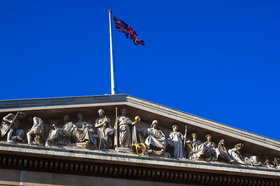

Having entered we gathered in the Great Court, the largest covered space in Europe I'm told, for an introduction to the collection, how it came about and developed into one of the largest and most comprehensive in the world; then we were off:

The Rosetta Stone was the first item - arguably the most well known and, judging by the numbers of visitors that gather around it daily, one of the most popular. Well justified given its role in finally being able to decipher Egyptian Hieroglyphs after 1400 years!

The Parthanon Sculptures followed - so Ancient Greece and the Acropolis. The Parthanon, or Temple to the Goddess Athena Parthanos, was built in just 15 years (447-432 BC) and still sets the standard.

There are three kinds of sculpture: a low relief frieze depicting scenes from a great procession; the metopes with high relief sculptures of a mythical battle (picture); and full statues from the pediments at each end of the building. Even though these marble sculptures are damaged and/or defaced all agreed they are nonetheless dignified and beautiful.
We then travelled to another Continent - the Indus Valley and the discovery of an ancient civilisation of the 3rd Millennium BC about which nothing was known until some tiny seals, probably used for trade, were found. Subsequent archaeological exploration uncovered the remains of entire cities capable of sustaining populations of 30,000 to 35,000 people!

Why these cities were abandoned isn't clear, a shift in the course of the river, climatic change or perhaps a natural disaster, but large numbers of people appear to have been on the move. There seems to have followed a cultural merging and mixing of language and beliefs that perhaps gave birth to Hinduism. We looked at artefacts and exhibits representing some of the Hindu Gods, e.g. Shiva, Parvati & Vishnu, and the stories and legends associated with them.


The Mildenhall Treasure - 56lbs (25kgs) of solid silver tableware dating back to Roman occupied Britain of 4th C AD with a mix of Pagan and Christian symbolism reflecting the changes in belief occurring at the time.


 RSS Feed
RSS Feed
